Many website owners are recognizing the incredible potential of connecting with non-English speaking audiences and expanding their reach internationally.
We know how important it is to speak to people in their own language. We even translated our own website, WPBeginner, into languages like Spanish and Portuguese to reach more people around the world.
This journey has given us firsthand insight into the best strategies and tools for creating truly effective multilingual WordPress sites.
In this article, we’ll show you how to easily create a multilingual WordPress site. We will cover four different solutions, so you can choose the one that works best for you.
With each solution, you’ll be able to easily translate your WordPress posts, pages, tags, categories, and themes into as many languages as you like.

What is a Multilingual WordPress Website?
A multilingual WordPress website serves the same content in multiple languages. It can automatically redirect users to a language based on their region, or users can select their preferred language using a dropdown link.
There are a few different approaches used to create a multilingual website.
The first approach allows you to manually translate all the content into languages of your choice with the help of human translators.
The second method does not actually create a multilingual site but uses machine translations of your existing content by using auto-translate services.
However, Google Translate has stopped supporting new accounts for website translation. The other options are either not free or not very good in quality.
It goes without saying that manually translating your content is a much better approach. This allows you to maintain quality throughout your website. You can translate the content yourself or hire professionals to do that.
Getting Started with Your Multilingual WordPress Site
To create a multilingual WordPress website, you need the following items:
- A domain name (This is your website address that users will type into the search bar to visit your site, like wpbeginner.com, for example)
- WordPress hosting (This is where your website’s files are stored)
- A multilingual WordPress plugin
If you don’t have hosting or a domain name yet, we recommend using Bluehost. It’s one of the largest hosting companies in the world, and it’s officially recommended by WordPress.org.
Plus, Bluehost is offering WPBeginner users a free domain name, free SSL certificate, and 60% discount on hosting. Basically, you can get started for as low as $1.99 per month.
If you are looking for an alternative hosting solution, then we also recommend Hostinger. It also offers a free domain name, SSL certificate, and a generous discount on hosting.
After signing up for hosting, you can follow this tutorial on how to make a WordPress site for step-by-step instructions.
Choosing a WordPress Multilingual Plugin
There are several WordPress plugins that you can use to translate your website into multiple languages. You need to choose a plugin that helps you easily manage translations without making things unnecessarily difficult for your users.
In this guide, we will show you four of the top WordPress multilingual plugins with step-by-step instructions on how to set them up.
If you know which plugin you are going with, then you can directly jump to the instructions.
All four of them come with the necessary features you’ll need to make a robust multilingual website.
- They allow you to translate posts, pages, products, and other post types
- You can easily translate your categories, tags, plugins, and themes
- They allow you to set up SEO friendly URLs for each language
With that said, let’s get started.
Method 1. Create a Multilingual WordPress Website Using Weglot
Weglot is one of the best WordPress translation plugins on the market. It uses powerful neural machine translation to immediately translate the original content on your website.
It is a bit different than some other solutions mentioned in this guide. Normally, multilingual plugins ask you to create multiple versions of the same article in order to translate it.
But, Weglot instantly translates your page and post text, as well as other content such as footers, menus, widgets, lead generation forms, theme elements, metadata, image alt text, and more.
If you want to learn more about this tool, you can check out our detailed Weglot review.
To get started, you need to create a new account by visiting the Weglot website. Simply enter your email address and password, then click on ‘Sign up’ to complete the registration.
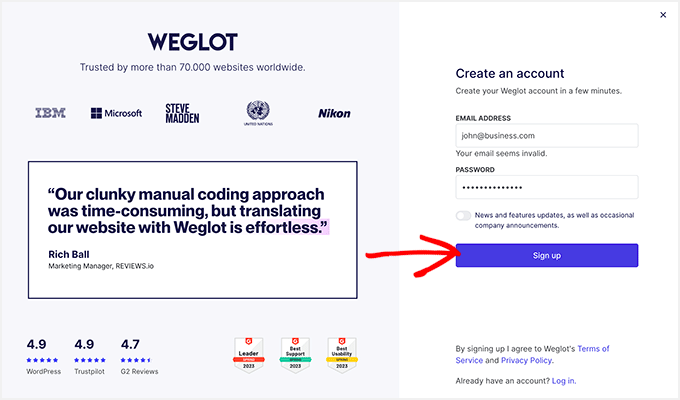
You’ll then be directed to the ‘Projects’ page. From here, you need to enter a name for your new translation project, which can be anything you want.
After that, you need to tell Weglot what type of website builder you’re connecting. Since we’re using WordPress, select that option from the dropdown list.
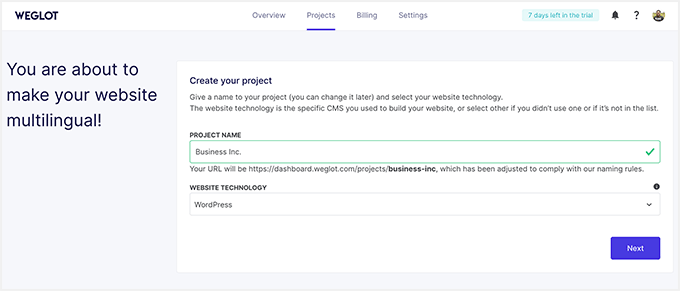
Click the ‘Next’ button to continue.
Now, you can follow the step-by-step process on the screen for installing and setting up the free Weglot plugin on your WordPress site. For more help, check out our complete guide on how to install a WordPress plugin.
You also need to copy the API key that Weglot provides you.
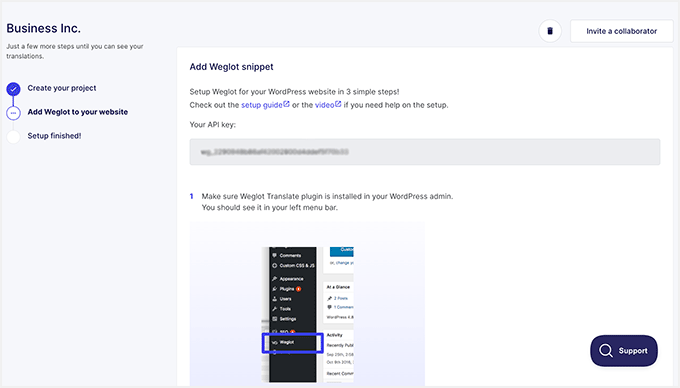
Once the plugin is installed and activated, paste the key to the ‘API Key’ field in the ‘Main configuration’ area of the plugin.
After verifying your API key, you can choose the languages you want to translate into. Simply click on the ‘Destination languages’ dropdown menu and select a language from the list.
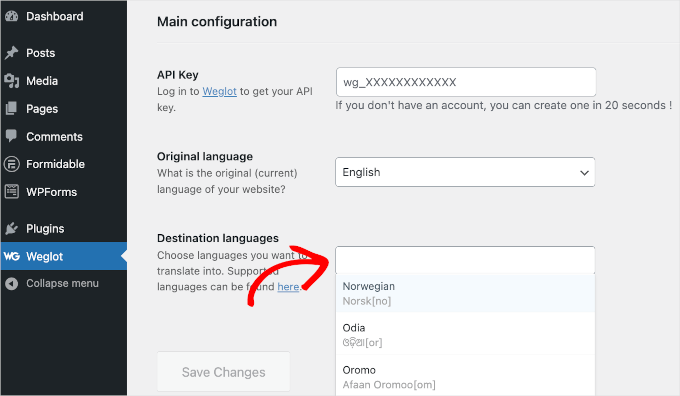
Weglot supports more than 110 languages, so you can choose more than one language if you want. When you’re finished picking your destination languages, click on the ‘Save Changes’ button.
After a few seconds, you’ll see a success message that says ‘Well done! Your website is now multilingual.’
To see your website translations in action, you can click on the ‘Go on my front page’ button.

Now, scroll down to the dropdown menu at the bottom right corner of your screen.
Weglot will automatically display a language switcher on your website. You can click on it to switch to the language you chose as your destination language.
This will instantly translate the entire page.
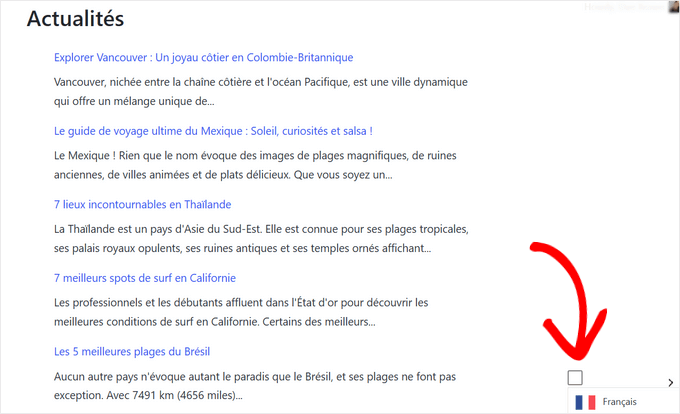
That’s it. You’ve successfully created a multilingual WordPress site with Weglot.
Method 2. Create a Multilingual WordPress Website Using TranslatePress
TranslatePress is another great translation plugin, similar to Weglot, that you can use to instantly translate your WordPress site directly from the front-end.
You can combine machine and human translations. This means you can use Google Translate or similar AI-powered tools to generate machine translations and only improve the parts that artificial intelligence missed.
It also allows you to use a live editor to translate all the visual aspects of your website.
The first thing you need to do is install and activate the TranslatePress plugin. For more details, see our step-by-step guide on how to install a WordPress plugin.
If you want to translate your website to more than one language, then you will also need to install the ‘Extra Languages’ add-on. You can do this from the download addons button under your account on the TranslatePress website.

After downloading the add-on, you can install and activate it like any other WordPress plugin.
Upon activation, you need to visit the Settings » TranslatePress page to configure plugin settings.

First, you need to switch to the license tab and enter your license key. You can find this information under your account on the TranslatePress website.
After that, you need to switch to the ‘General’ settings tab to set up other settings.

The first option on the page is to choose the default language of your website and the languages you want to translate your website into.
Next, you need to choose whether you want to display language names in the native language. The default option is ‘No’ which means language names will be shown in the default language.
After that, you need to choose whether you want to display the default language name in the URL as a subdirectory. For example, http://example.com/en/.
The default choice is no which means only the other languages will have the language name in the URL as a subdirectory. We recommend leaving this setting as-is for WordPress SEO.
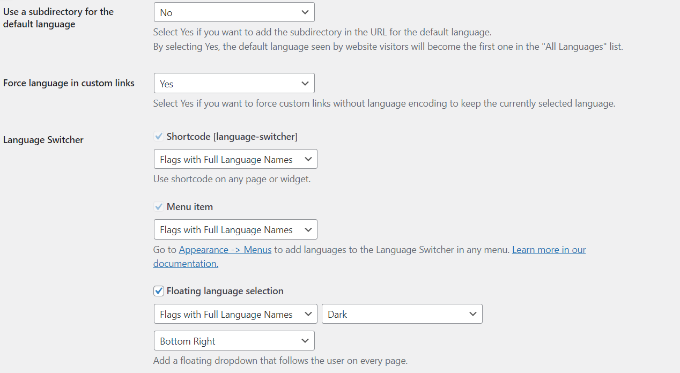
This brings you to the next setting, ‘Force language in custom links’. The default option is ‘Yes’ because that will change custom links for translated languages, making the URLs more SEO-friendly.
Next, you need to choose whether you want to use Google Translate for automatic translations. The default choice is ‘No’, but you can change that if you would like to use Google Translate.
You will need to provide a Google Translate API key in the next option. You will find a link under the option, which will show you instructions on how to get one.
Finally, you will come to the options on how you want to display the language switcher on your website. TranslatePress provides you with three choices.
You can use a shortcode, add a switcher to your navigation menu, or display a floating menu. We will show you how to add the language switcher to your website later in this article.
Go ahead and click on the ‘Save Changes’ button to store your settings.
Translating Your Website Content
To translate your website, you can simply click on the ‘Translate Site’ tab on the plugin’s settings page or the button in your WordPress admin bar.

This will open the live translation editor in a new browser tab.
In this live editor, you can click on any text on your website in the right pane and TranslatePress will load it in the left column to translate.
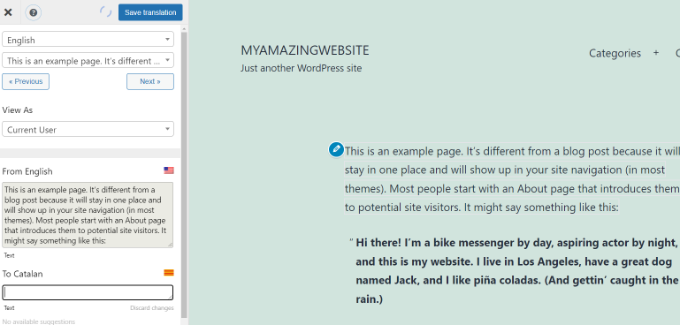
Now click on the language you want to translate the string into and then provide your translation.
After entering the translation, click the ‘Save Translation’ button on the top and then click on the ‘Next’ button. TranslatePress will automatically load the next string on the page for you to translate.
You can also just click on the drop-down menu below your default language, and it will show you the list of translatable text strings on the page. You can select a string and then provide its translation.

You can translate all content on any page. This includes navigation menus, buttons, sidebar widgets, meta-text, and more.
You can also visit any page by clicking on the links on the screen and start translating that page.
TranslatePress allows you to instantly translate any page or post on your site when logged in. Simply click on the ‘Translate Page’ button on the top to enter the live editor.

Once you have translated a string, the plugin will automatically translate it for you in other places. For example, if you translated a post title, then the post title in your sidebar widgets will be automatically translated.
Adding Language Switcher to Your Website
Language switcher allows your website visitors to select a language when they visit your website. It usually displays the flag of each country to indicate languages available on your site.
TranslatePress allows you to add a language switcher by using a shortcode, as a navigation menu item, or as a floating banner. The language switcher can be displayed as flags, language names, or both.
Adding language switcher in WordPress using shortcode
You just need to add [language-switcher] shortcode to posts, pages, or a sidebar widget where you want to display the language-switcher.
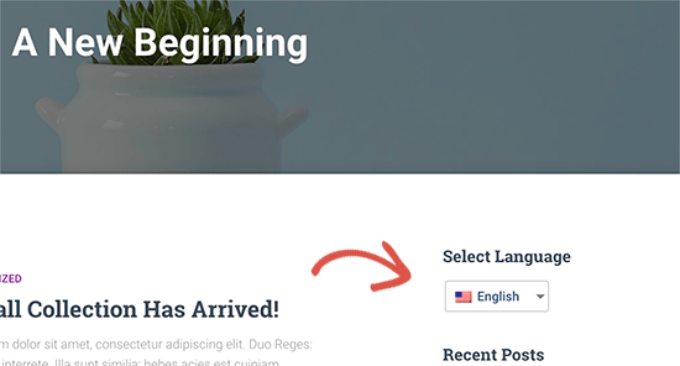
Adding a language switcher to your WordPress navigation menu
Simply go to the Appearance » Menus page and click on the ‘Language Switcher’ tab in the left column. Now select the languages you want to display and then click on add to menu button.
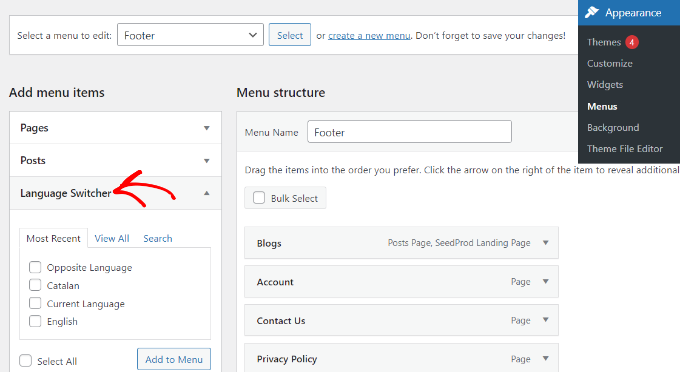
You will now see languages added to your WordPress navigation menu. Don’t forget to click on the ‘Save Menu’ button to store your changes.
This is how it looked on our test site:

Adding a floating language switcher
Go to the Settings » TranslationPress page and head over to the General settings tab. After that, scroll down to the language switcher section.
From here make sure the box next to the ‘Floating language selection’ option is checked.
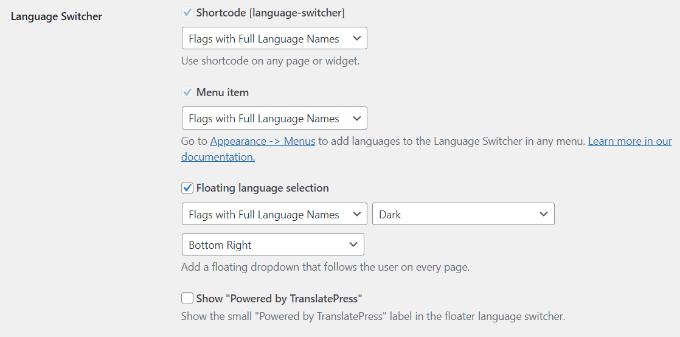
Don’t forget to save your changes.
You can now visit your website to see the floating language switcher at the bottom of every page on your website.

Method 3. Create a Multilingual WordPress Website Using WPML
WPML (short for WordPress Multi-lingual) is one of the oldest and most popular WordPress multilingual plugins.
First, you need to do is install and activate the WPML (WordPress Multi-language) plugin. For more details, see our step-by-step guide on how to install a WordPress plugin.
Upon activation, the plugin will add a new menu item labeled ‘WPML’ in your WordPress menu. Clicking on it for the first time will take you to the plugin’s settings wizard.

WPML will automatically detect your WordPress site’s language. You can change it here now if you want.
After that, click on the ‘Next’ button to continue.
On the next screen, you will be asked to select the languages you want to enable on your site. Simply select the languages from the list that you want to add to your site.
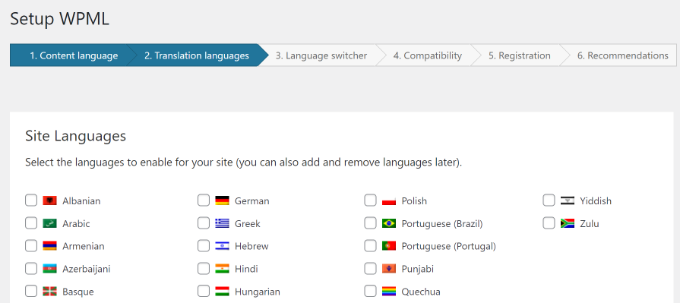
You can always add or remove languages later if you need them. Once you have selected the languages, click on the ‘Next’ button.
Now, you will be asked to add a language switcher to your site. This language switcher will allow your users to choose a language to view content in their preferred language.
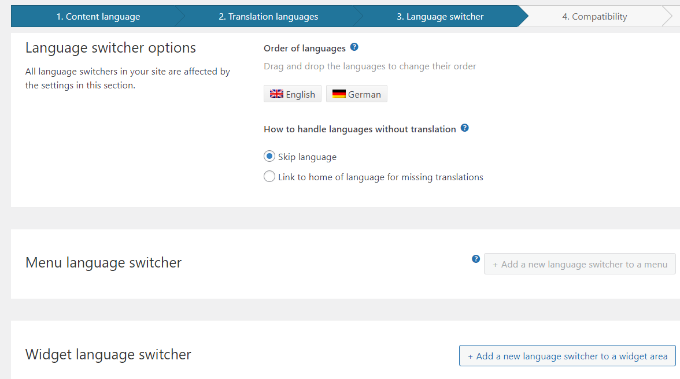
WPML allows you to automatically add a content switcher as a sidebar widget, in your navigation menu, a plain list, or in the footer area.
Next, you will be asked if you like to send a compatibility report to WPML regarding the plugin and themes you are using.
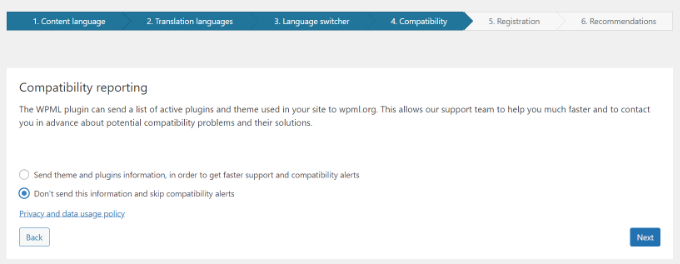
It is up to you to decide whether or not you want to send this data to WPML.
As the final step, you will be asked to enter your site key. If you have not generated one yet, then you can click on the ‘Generate a key for this site’ button.
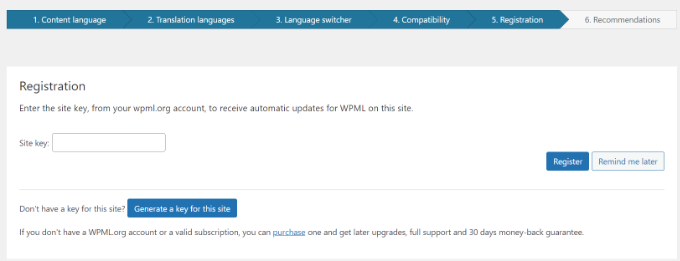
This will take you to the WPML website, where you will be asked to add the site you are coming from to your WPML account.
Once your site is added, you can click on it to get to your site key. Copy and paste this key into your WordPress site.
That’s all you have successfully finished the WPML setup wizard. You can now click on the Finish button to exit the setup.
Adding Multilingual Content into WordPress with WPML
WPML makes it really easy to translate every area of your WordPress site into multiple languages.
You will be able to easily translate your WordPress posts, pages, tags, categories, and themes into as many languages as you like.
Adding Multilingual Posts and Pages
Simply click on the posts menu to view your existing posts. You will notice the language column next to your post titles.
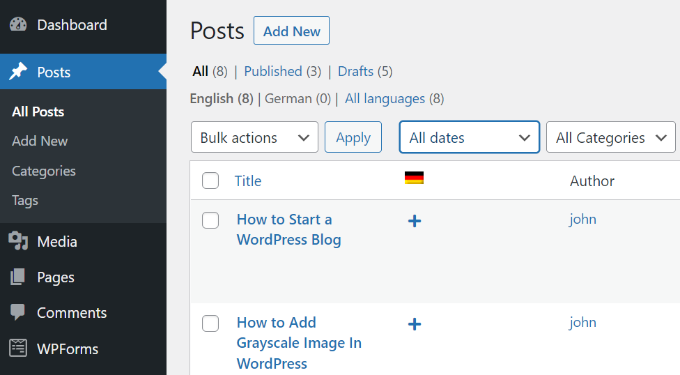
WPML assumes that your existing content is in your site’s primary language. It will show Add buttons for each language next to your posts. Click on the add button (+) under a language to translate a post.
You can also manage translations by editing a post.
On the post edit screen, you will notice the new ‘Language’ meta box to manage translations.
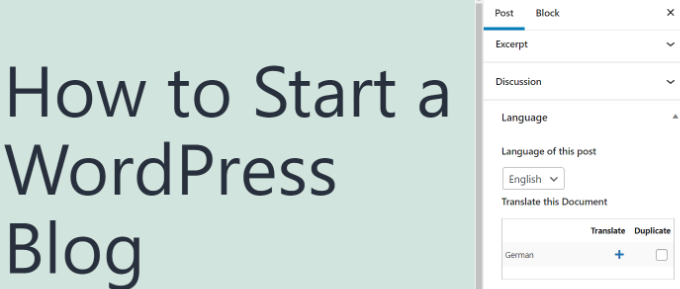
WPML also offers a better way to manage users who work as translators on your website. If you purchase their Multilingual CMS Plan, then you can use their translation management module.
The translation management module allows you to add users as translators regardless of what role they have on your WordPress site. You can even add subscribers as translators. Instead of editing posts, these translators will be able to add translations directly in WPML.
Adding Translations for Categories and Tags
WPML allows you to easily translate categories and tags, or any other custom taxonomies that you may be using.
Visit WPML » Taxonomy Translation and load the custom taxonomies you want to translate.
For example, in this screenshot, we selected categories, and it displayed all categories from our example site.

Click on the add (+) button next to the taxonomy term to add the translation.
Translating Navigation Menus
WordPress comes with a robust navigation menu system. WPML allows you to translate it just like you would translate posts or taxonomies.
Visit the Appearance » Menus page on your site. If you have more than one menu, then select the menu you want to translate.
In the right-hand column, you will see your menu with links to translate into other languages enabled on your site.
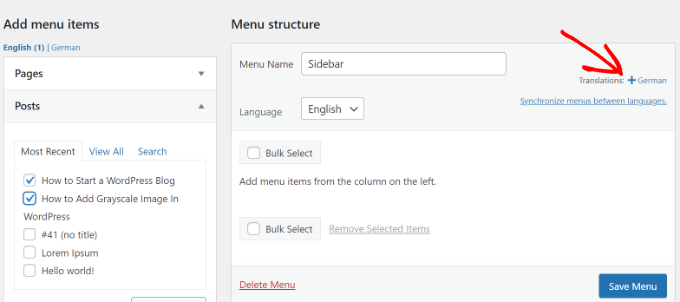
Clicking on a language will create a new menu for that language. You will need to add the same menu items as in your primary language menu.
If you have your pages and posts in navigation menus, then you will first need to translate them. After that, you can add them from the tabs on the left in the edit menu screens.
Don’t forget to click on the ‘Save’ button to save your menu.
Note: If you are using a WordPress theme that uses the full site editor, then you can edit your navigation menus under WPML » Translation Management.
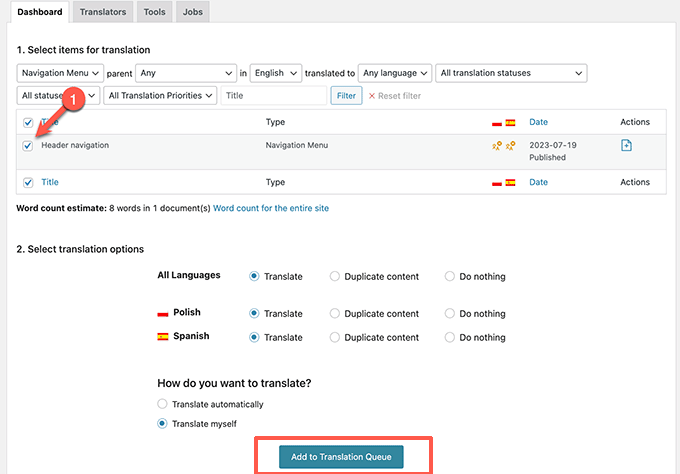
Translating Themes, Plugins, & Other Text with WPML
WPML multilingual CMS allows you to choose between official translations of themes and plugins or use its own string translator.
Go to WPML » Themes and plugins localization page.

By default, WPML will look for your plugin’s translation files if they are available, and use them.
However, if your WordPress theme or WordPress plugins are not translated into the languages you are using, then you can translate them using the WPML string translation feature.
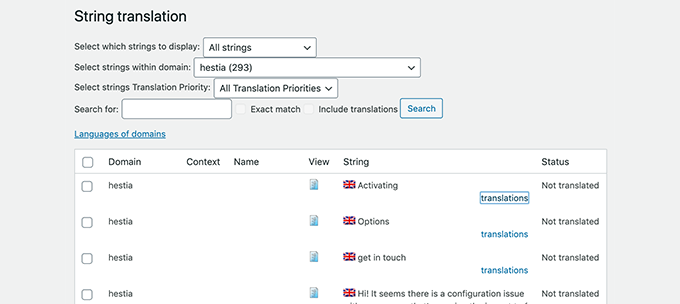
Simply scan your theme or plugin to load the strings and then start translating those strings.
This module will also allow you to translate custom fields, widgets, and other translatable strings generated by WordPress.
Method 4. Create Multilingual WordPress Website Using Polylang
Polylang is a free WordPress multilingual plugin with more than 700,000 active installs. It allows you to easily create a multilingual website without purchasing the premium version.
Note: If you are running WooCommerce or need support, then you may want to upgrade to the Polylang Pro or purchase their WooCommerce addon.
For this tutorial, we’ll be using the free version of the plugin.
The first thing you need to do is install and activate the Polylang plugin. For more details, see our step-by-step guide on how to install a WordPress plugin.
Upon activation, you need to visit the Languages » Languages page to configure the plugin.
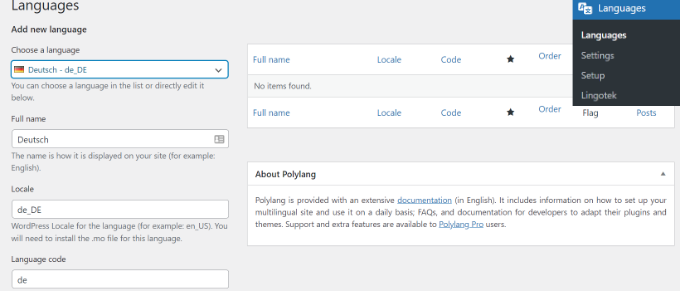
The language settings page is divided into three tabs. The first tab is labeled ‘Languages’. This is where you add the languages you want to use on your site.
You will need to add the default language, as well as select all other languages that users can choose on your site.
After adding the languages, switch to the ‘Strings Translations’ tab. Here you need to translate the site title, description, and then choose the date and time format.
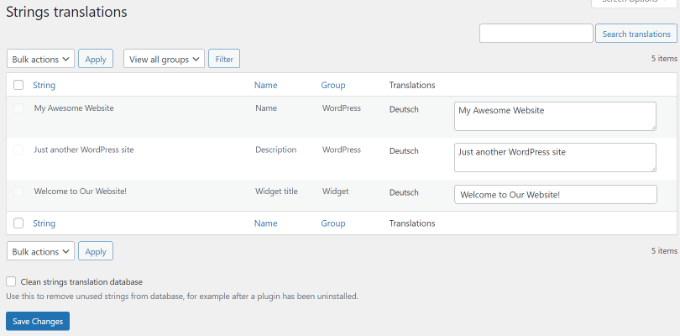
Next, you need to visit the Languages » Settings page. From here you can set the URL settings for languages and set up SEO-friendly URLs.

To change the URL settings, simply click the ‘Settings’ option under URL modifications. After that, you can configure your URLs and choose whether you’d like to show the language in your links.
For example, you can show URLs such as https://example.com/en/my-post/ on your website.
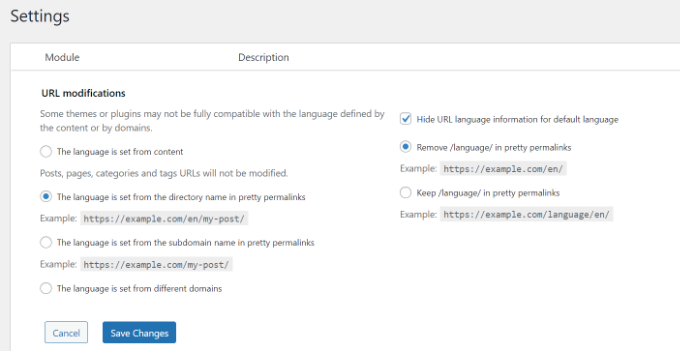
Once you are done, click on the save changes button to store your settings.
Translating Content in WordPress with Polylang
Polylang makes it super easy to add content in different languages. Simply create a new post/page or edit an existing one. On the post edit screen, you will notice the language meta box.

Your default language will automatically be selected, so you can first add content in your default language, and then translate it into others.
To translate, you need to click on the + button next to a language under ‘Translations’ and then add content for that language.
Repeat the process for all languages. Once you are done, you can publish your posts and pages.
Translating Categories, Tags, and Custom Taxonomies
You can also translate categories and tags, or any custom taxonomies you may be using.
If you want to translate categories, then go to Posts » Categories.

Add a category in your default language and then click on the plus icon for each language to start adding translations.
Displaying Language Switcher on Your WordPress Site
Adding a language switcher allows users to select a language when viewing your site. Polylang makes it super simple.
Just go to Appearance » Widgets and then click the ‘+’ button at the top to add the ‘Language Switcher’ widget block to your sidebar or another widget-ready area.
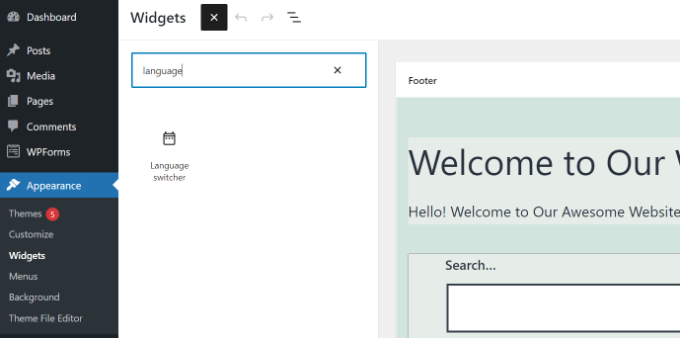
You can now enter a title for your widget, enable options for showing a dropdown, displaying language names, hiding current languages, and more.

Once you are done, click the ‘Update’ button to store your widget settings.
You can now preview your site to see the language switcher in action.

FAQs About Creating a Multilingual WordPress Site
Having helped thousands of beginners start their websites, we know a thing or two about making a multilingual website. Following are some of the top questions we have been asked about multilingual WordPress websites.
1. Which WordPress multilingual plugin is the best?
All four plugins mentioned in this guide are the best. However, they are slightly different in some aspects.
If you are a beginner looking for an easier solution, then we recommend using Weglot. It automatically translates your entire WordPress website.
TranslatePress is also a good option because its live editor is easy to use.
Advanced users and eCommerce websites may find WPML more comprehensive for their needs. Lastly, if you are looking for a free solution, then Polylang is the best option for you.
2. How to translate my WordPress admin area for users?
WordPress allows each user on your website to select the admin interface language. They simply need to edit their user profile and there they will find the option to select language.

3. How do I translate my WordPress theme?
All four plugins will allow you to automatically fetch theme translations. You can also find and translate a WordPress theme by yourself and then upload translation files to your website.
4. How do I translate a WordPress plugin?
Many of the top WordPress plugins are translation-ready. However, they may not be translated into all languages. Weglot, TranslatePress, and WPML allow you to easily translate strings within the plugin interface.
You can also translate WordPress plugins on your own and upload the translations to your website manually.
We hope this article helped you learn how to make a multilingual WordPress site like a pro. You may also want to see our guide on how to easily get more traffic to your website and the best live chat software for small businesses.
If you liked this article, then please subscribe to our YouTube Channel for WordPress video tutorials. You can also find us on Twitter and Facebook.





Ian
Hi, when I add the plugin to my site my menu disappears. I also have my recent log posts on the front page and they also disappear. Any fix to this?
Br
Sally
You seriously need to make it very much clearer that when you use wp.com you cannot add plugins.
I have just discovered this and neither on WP site (including this site) or on the WPML site did it say YOU NEED TO BE ON WP.ORG!!!!
WPBeginner Support
Hi Sally,
We are sorry, you had to face this situation. At WPBeginner, we try to clarify this whenever possible. Please take a look at our guide on the difference between WordPress.com and WordPress.org.
Please note that you can get a full refund for your WordPress.com account for 30 days after registration. You can get refund for a custom domain with next 48 hours of registration. Need help starting with WordPress.org? Check out our how to start a WordPress blog page.
Admin
Mike Quinn
Sally, that’s kind of a given. Anyone that is serious about having a website IS NOT ON WORDPRESS.COM. Especially on a wordpress subdomain.
gagan virk
click on flag language change but video no change
sir i want click on flag language with video change sir plz help me now
Maroua
Great Post,
for me worked at the first attempt. I’ve also created a custom widget area and placed the Language switcher widget inside of it and, great it works. Thank you for the tutorial!
Deepak Bhardwaj
hey thanks buddy a great help, and did worked for me. but i am stucked in home page, i dont want to create static page or a static page with dynamic feature, i am just using my post as my home page as the theme i am working on provide me different section to post static data and regular posts as well. but i dont know how and from where to enter that static content for home page.
Nallely Padilla
Hello! I am trying to do as you say, I downloaded the polylang but when I tried to add it to the plugging setting, it says “uploading your own pluggins is not available on wordpress.com”
What can I do to active this polylang feature? This is urgent!
Thank you!
WPBeginner Support
You are using WordPress.com. Please see our guide on the difference between self hosted WordPress.org vs free WordPress.com blog.
Admin
Helene
Hi there!
I am trying to convert my website into a bilingual site using Polyland, but the video only shows how to add posts in multiple languages. I have only pages (we’re an advertising agency), and no posts, and I cannot find a solution to translate pages and menu options. Would you please be able to advice?
Imran Khan
Hi there!
Thanks a ton for this wonderful post. You’ve made my day!
I’m relatively new to WordPress and would like to know that when I use Polylang plugin on a WooCommerce website, how will I be able to translate default texts like “Add to Cart”, “Quick View”, “View Cart”, “Checkout”, etc.
Basically, I’m looking forward to create an online store with options of selecting languages from English/ Russian from the front-end and get the complete translations in a proper way.
Thanks in advance.
Matthieu
Hi,
installed the plugin but
1/ there is not option to set the default language
2/ after installing the plugin and following the tutorial I had 2 languages, including English which should be the default language. However when trying to visit the English version I have an error and actually can’t access the site anymore
Can you help with that?
Cheers,
Mat
WPBeginner Support
Please visit Settings » Languages page. First you need to add the languages you want to use and then click on Settings tab to select a default language.
Admin
Eva
Hi there,
Thank you for this tutorial. I don’t know why, but I don’t have the language option in the setting in my dashboard. Could you help, please?
many thanks
MNH48
Does polylang use many resource? I’m asking this because I’m using free hosting now (as I’m just a student without jobs, paid hosting are too expensive >_<) and free hosting have limits on resource, plus it is on shared server :3
If polylang use many resource then I might make separate sites (with separate free hosting) for English and Malay, but if it uses less resource then I will stay on one site and just use polylang…
– Muhammad Nur Hidayat (Nicknamed MNH48) –
Sergey
Thanks for this tutorial.
I have a strange request from my client: to translate site to something around 5 languages, BUT widget must show over 20 flags. How he wants it to work: USA, UK, Australia flags, for example, must lead to the same translated English content. The same with Spanish (Spain and latin America flags), and some other languages.
How could I do this with this plugin? Is this plugin support such features?
Arif
Thanks Dude, I used it on my website and its working fine.
blaem01
i like it
Kalin Stanishev
I like Polylang, but how can I get some of the pages ONLY in one language. For example, if I make website to learn Italian, I don’t need Italians wandering around…
The thing is that when I get it up and running, I need to have ALL web pages in ALL languages and this is a bit annoying.
Can anyone help with that?
Harsha
Doesn’t it have south Indian languages Kannada, Telugu, Malayalam? If not, is there any other plugin having those languages?
Richard de Laat
Transposh is a good plugin as well, with many languages and good functionality.
Agnieszka
I have istalled the plugin for the multilanguages and now my website is off….please help. What can I do to have my website live again.
hector
@wpbeginner, does google punish websites that does not use manual translation?
Ruslan
Hi,
Thanks for the information.
I am new and have little knowledge on WordPress. I would like to have my WordPress website in 3 different languages. Can you please let me know if the plugin allow the visitors view the pages of my website in other languages as it is done in this website:
1. When browsing in one particular page if you click to the language icon you will be taken to the same page but in different language (not to the home page). I would like to have similar.
.
2. It would be if it would be possible to edit the links (to have links in German for German version of the page) like here
Could you please advise if it would be possible with the plugin to do the same as it is done in the reference website ?
Many thanks for your patience
Ruslan
Niko
Hello,
amazing article
but if I can.. there may be another solution for having a multi-lingual website easily.. with human-powered translations and of course FREE
Ishtiak
Thank you for this tutorial!
I never thought there is an option for enabling multi language in a same Wordpress blog!
I am running a small blog for about 2 months. If I install and activate this plugin, will this hurt my blog SEO?
Thanks again!
Basic account
I tried with the google translation plugin but my account does not allowed me, is this only for payed accounts? Thanks
mehnaz
Dear,
my site is in English language , but I want to add Bangla language. When I add Bangla the website looks new. The site is no more if i set language in Bangla. and the English lanuage is already exists. But when I add English, it looks again empty. How I would do make all English existence blog onto this form. Please help. I am waiting to get your answer
WPBeginner Support
First you need to set a default language. Then make sure all content in that language is filed under proper language.
Admin
Ishtiak
I have also tested this plugin for Bangla language. I got the same issue, But I have figured it out too. First add English language, then it’ll be your primary language. Then add Bangla. You need to set all your Menus newly. I got no alternative way for this.
Thanks.
Mehnaz
Thanks a lot. , I have done it.
Dorit
At last an easy solution for what I have been looking for and well explained. Thank you!
Jess
This is just perfect, so happy to have found this post! Thanks a ton!!!
Mahmoud fared
Hello everyone
I am creating a holidays website and I wish to know how to add the countries and cites to the website to let the customers choose the place they would like to go to.
Can you please tell me how ? I been looking for nearly 1 week but I couldn’t find it .
Thank you
WPBeginner Support
You can use custom taxonomies for that.
Admin
Ben Pines
Amazing video – you managed to condense this rather complicated subject to a 2:30 video. Nice.
I think people aren’t aware that there is a huge difference between the plugin solution and the Multisite.
I have written a rather long post about which solution is recommended, and for which type of site:
Oscar
Can you share the post that you mention? Thanks
Joe
Fantastic! With a minimum of fuss, I got the site up, running and looking good! Thanks! Slight changes due to the new version, but nothing hard to figure out.
Ron
I have an “orphan” theme I bought from Shotzz by WPTitan that was abandoned a few years ago. So suggesting we contact the theme support doesn’t work for those of us with orphans. I tried “converting” to a newer theme but its a no go. I am stuck or i have to completely redo my site in order to get my site bilingual. thanks
Jameela Tey
Careful with the WPML plugin!!
I have been using the WPML plugin for some time… what was to follow was a nightmare… we ran the plugin for a 2nd language for quite some time… and then figured that the plugin was quite a resource hog – as measured by: P3 (Plugin Performace Profiler). We saw that 70% of the resources consumed on our website were by this Plugin. And that by removing WPML we could speed up response time of our website by up to 50%.
So we decided to uninstall the plugin and run the 2nd language manually. What was to follow was and still is an ongoing nightmare.
WPML the plugin from hell, will modify the database irreversibly. So that after uninstalling the plugin the database is compromised.
The result is that permalinks on the website are wrong. We had countless conversations with WPML support and they could not provide a solution. So we have now programmer working on this manually changing links in the site… back to what they are supposed to be.
All hell broke loose when we upgraded from WP version 4.3 to 4.4 – that is when the links in the site got screwed up.
And we have to pay dearly for this reparation of the site. Our programmer is still working on getting rid of the damage that WPML did to our website.
So be very careful betting your site on the WPML plugin. For us it turned out to be a huge mistake.
And we had to learn that their support sucks greatly.
Rosinaldo Dourado
Hello.
I use the Divi Theme 3.0 from Elegant Themes
I need to translate my website and I’m looking for an automatic or automatic with manual revision enabled translation.
Look here how WPML works with Divi Theme:
Do you think that WPML still is a bad choice? Could you comment on the above post?
Thank you.
Kaspar
Excellent, just what I needed.
Cheers.
Kelvin
My website go down after I added the new language (english-US) to the list.
The error display :
“Server error
500”
Then I can not access my admin page also with the same error.
Would you please advise what to do ?
Thanks.
fox
for my taste it gets cluttered to fast since polylang creates a new post for each translation ….
Zerano
You can filter the displayed languages in the top menu !
Terry
This was exactly what I needed to know to help a client who is a Japanese consultant. Thanks so much. Hopefully when I actually try it, it will be as easy as it appears in your video.
Jeannette
How can I use different footers for the two different languages on my site?
Thanks in advance.
Paula
I have the same question too.
daslicht
folders?
Katja K.
Thanks a lot for this tutorial. I just tried it out though and have one question:
Once I install Polylang, my theme settings change automatically (Jupiter Theme) and I can´t see my logo and my menu anymore. I see the standard Jupiter header and the link “add menu” on the upper right corner. Have you also experienced such thing and how can I fix it?
Thanks a lot in advance.
WPBeginner Support
Please contact your theme support.
Admin
Prabhu
This plugin Google Language Translator is having issues, is there any different plugin good as this one to use because this breaks the site. Kindly advise if anyone know, thank you.
Kindly advise if anyone know, thank you.
Aly Elgarhy
when i activate this plugin and apply this setting like tutorial all my post and pages disappear and when i deactivate it all back again
Maurizio
Hello, the same thing happens to me. Do you know how to fix it?
cheers
marurizio
Craig
Same happen to me using vitue theme and woocommerce
daslicht
have you tried to set the default language
Lost Menus, No default
I saw no default language setting in the plugin, only in wp “settings”, “general” but not in the “languages” section. So the tutorial is incorrect or the newer perhaps version of the plugin is faulty. I had to deactivate and gracias a dios my site was okay.
Natalie Kani
Amazing article and the video – thank you very much!
Just one question, what do you think would be the best option to make a multilingual site (keeping English as the main backend language), which does not require translations – the content would differ depending on the language?
thank you a lot again, very valuable site!
Melody Tabatabaian
Thank you for your very helpful website and clear instructions. Your tips helped me translate a website from top to bottom. Thank you again!
Sincerely,
Melody
Carolien
Hi there, thanks for your very helpful tutorial. Would you happen to have any experience with this plugin combined with the OneEngine theme. The minute I install the Polylang plugin my menu disappears, which is quite essentials to have. Any tip or tricks to avoid this?
Many thanks.
WPBeginner Support
Please contact your Theme’s support team and let them know about the conflict. You may also contact Polylang plugin support.
Admin
Milica Z.
Thank you for all tutorials you guys do and especially this one. Two questions tough: 1. Is there a way to move flags in the header menu in the upper right corner? 2. How to deal with new post subscriptions for multilingual blog, without sending ‘duplicate’ emails, for both languages to subscribers?
Dirk
Hi Milica,
did you find out how to put it to the top right close to the menu?
Thanks
dirk
Milena
Hi, how can i put flags to be side by side? Right now one is up and the other is below it?
Thank you, Milena
petitesoeur defoulee
Does it work only for wordpress.org ? I’m trying to install it but my blog is supported by wordpress.com
Thanks in advance
WPBeginner Support
Please see our guide on the difference between WordPress.com and WordPress.org.
Admin
Maikel Markx
Hi,
Thanks for the helpful tutorial. So I get how to translate different pages and posts, but how do I translate a theme that is being edited via appearance -> customize? Thanks a lot.
Maikel
Olga
You’ve got an amazing site! So much useful advice, I’ve already used many of these, I don’t even remember how many, but you’re becoming my goto site :) The htaccess, the my own plugin (I never thought I could do this, and this got to be so simple!), and endless other things. I do not comment a lot, but reading this post now, with exactly what I needed explained so much in details, I just had to tell you: THANK YOU!!! Very much! For all you do! It is amazing how you go into all these details, with such quality. Thank you very much!
Piet
Although I realise that this site basically is aimed at beginners, I find it kinda strange to actually include Google Translate in this article.
Yes, you can use it to quickly translate a word or a short sentence perhaps, but a site?
For many languages the “translations” that Google Translate offers are horrendous at best.
That the translations for Dutch are far from great perhaps is understandable as it not only is a very difficult language, it’s also only spoken by a handful of people.
But the two languages that are even (far) more popular than English, namely español (Spanish) and 中文 (Chinese) have incredible poor translations to and from English.
I think especially to WordPress Beginners it is your responsibility to teach them the value of reliable content on their sites and that naturally includes translations.
Also a good tip for people looking to offer their site’s content in different languages is that they should keep in mind that site visitors also expect to be able to fill in contact forms in those languages and expect to receive replies in their native tongue!
WPBeginner Staff
Piet we share and agree with your concerns. This is why we described in great details on how users can translate their own site using polylang.
We have also described that using Google translations the quality of translations will not be good.
However, we felt some users may just want to save visitors a visit to Google translate by offering it on their own site. Not all users can afford to get their site content translated into multiple languages.
Giorgos Pishilis
Thank you. It took me five minutes to read and do everything.. But it will take me a month to translate the whole page. Cheers this was extremely helpful!
WPBeginner Staff
Thanks for the suggestion, we will try to do a comparison very soon.
Eduardo WB
Thank you! I will test the Polylang plugin. I have been using older ones that have some issues in the new Wordpress projects, so this post is very nice.
Mav35
Hi, would be great to have an article to compare this plugin to WPML or MultilingualPress. Multilingual website management can be more complicated than just translate post, pages and taxonomies and I’ve never found a good article on the Web about Wordpress multilingual alternatives.
Tammi L. Coles
Just to second Mav35’s request for a “wordpress multilingual plugins compared” post! I have been using WPML for years and really like that it is backed by support. But it is EXTREMELY complex, so not something that I recommend to folks without the stomach for it. But maybe that’s just me? A more in-depth feature comparison might just change my mind!
Thanks for all you do!
Ed Dogan
Just to third Mav35’s request. I was about to get WPML and pay them but I used polylang instead. The interfaces look simlar and not sure what I’m missing by not using WPML.
Mav35’s request. I was about to get WPML and pay them but I used polylang instead. The interfaces look simlar and not sure what I’m missing by not using WPML.